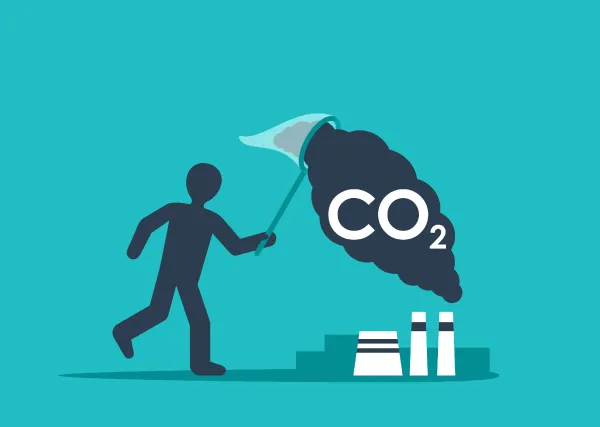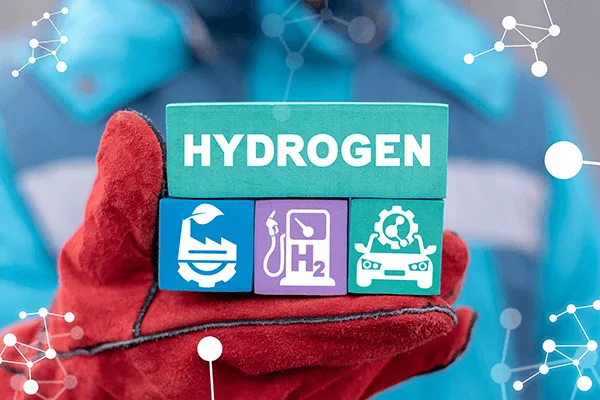The carbon cycle is a naturally occurring process linking the atmosphere, biosphere, soils, rocks and oceans. Anthropogenic means environmental damage caused by humans indirectly through various practices such as man-made industries including mining, oil and gas, energy production, shipping, and industrial farming. This has damaged the natural carbon cycle by pumping more CO2 into the atmosphere at a rate much faster than ever historically occurred.
While it’s easy to bash the companies, who were not that long ago considered progressive, oil majors etc, it’s many of these companies that now hold the key to solving the problem man has created. With increasing chatter around carbon capture technologies and implementation, it seems likely there will be many investment opportunities arising out of the sector in the coming years.
#An Overview Of The Carbon Capture Cycle
Since the industrial age began in 1750, humans have increasingly released CO2 back into the atmosphere. Many gigatons of carbon are released into the atmosphere from soil carbon pools resulting in the way we use and abuse the land.
In the past 270 years, the CO2 concentration in our atmosphere has exploded to the highest level seen in the past 650,000 years and one that is not likely to have been exceeded in the past 20 million years.
This increase is warming up the planet which is dangerous to current ecosystems and organisms. This explains why there is such a global push on reaching climate change initiatives such as the Paris climate agreement.
#What Is The Paris Agreement?
One such direction that companies are increasingly turning their attention is to capture the carbon and bury it deep underground. We know this process as carbon capture. Permanently storing CO2 is viable but expensive. There’s also the worry that it will just end up like our ever-growing landfill sites.
To effectively store and bury the CO2, industrial level processing can lock it up into a stable carbonate by using minerals to react with the gas in a high-pressure, high temperature environment. CO2 is removed from the exhausts of power plants or oil rigs, pressurized and piped underground for permanent storage. This is known as sequestration.
We are consuming energy at a faster pace than ever before, and this is still expanding as more and more nations strive for a better standard of living. Fossil fuels are still the main supplier of energy but the movement to renewable sources is picking up pace.
Even if CO2 can be captured and stabilized by 2100, global warming and other climate damage is projected to last for centuries.
This is fuelling an urgent requirement for carbon capture technologies that reduce the carbon emitted by limiting excess CO2 into the atmosphere or enhancing technology that reduces the excess carbon at source.
#Many Solutions To One Growing Problem
The Intergovernmental Panel on Climate Change is the United Nations’ body for assessing the science related to climate change. It estimates that we need to pull between three and seven gigatons of CO2 out of the atmosphere by 2050 to meet the Paris goal of 1.5° C.
Carbon capture and storage is one such way, but there are others. Extracting CO2 straight from the air is another option. This is known as Direct Air Capture and has slowly been developing over the past couple of decades.

Filtering with the use of chemicals or resin are in practice and work by absorbing the carbon in a filter where it can then be isolated with heat. Some smaller companies already working on these filtering technologies are found all over the globe. For example, Canadian startup Carbon Engineering Ltd, Dutch firm Skytree, Finland’s Soletair Power, Swiss firm Climeworks AG (raised $76m in a funding round last year) and US company Oak Ridge National Laboratory.
To move the air through the filter, some businesses are capturing the CO2 with the use of giant fans such as California-based Global Thermostat. Then there is the process that absorbs CO2 with the use of specialist membrane, such as that created by The Center for Negative Carbon Emissions (CNCE) in Arizona. While the Pennsylvania-based National Energy Technology Laboratory (NETL) is discovering ways to reduce CO2 with nanostructured metals.
#Shifting Gears
Then there are the many oil and gas companies looking at ways to carry out carbon capture and storage by utilising their deepwater knowledge and experience to capture the CO2 and bury it deep under the ocean in their old oil and gas wells.
Maersk Drilling is one such company looking at ways to utilise their already extensive knowledge in deep sea drilling to tackle capturing carbon in these hostile environments.
Some of the leaders in the carbon capture space focus on capturing the CO2 from large sources before emission takes place. For example, Occidental Petroleum, which was replaced by Tesla in the S&P 100 index, is pumping most of the carbon dioxide it emits back underground. Essentially this means it removes approximately 28 million tonnes of emissions that it would otherwise pollute the atmosphere with. This carbon capture sequestration equates to 4 million carbon burning cars annually. There’s no doubt Occidental still causes way more pollution than it saves, but the fact it’s making strides in sequestration shouldn’t be ignored.
Danish firm Ørsted was formerly an oil and gas company called DONG Energy but now it’s firmly established itself as a renewable energy multinational and there are several more following in its footsteps. Even the majors such as BP, Royal Dutch Shell, Total and Chevron are all making moves into renewables. Just this week ExxonMobil announced a $3 billion investment into carbon capture and storage over the coming five years. While BP is joining forces with Russia’s Rosneft to evaluate opportunities for carbon capture and hydrogen.
Meanwhile, in the East, China has committed to large-scale carbon capture projects and its Ministry of Ecology and Environment is fully behind the initiative. That’s because ramping up viable capture carbon solutions are vital to its effort to become carbon neutral by 2060. It’s reportedly keen to implement nature-based solutions such as reforestation and wetland restoration programmes.
#Recycling Carbon Is Not All Plain Sailing
Some advocates for carbon capture realise that rather than simply storing it forever underground, it would be better if it could be put to use. Some solutions could be to boost vegetable yields that benefit from a high presence of CO2. Alternatively, it could be used as a feedstock for carbon-neutral fuels. Recycling the CO2 to create carbon-neutral fuels is a great concept, particularly for sectors that are not ready to be electrified. But burning it still releases harmful gases, so it’s not that great a solution overall.
Burying carbon at sea sounds simple enough, but it’s far from it. While some theoretical solutions have been around for decades, it’s the implementation that’s tricky. Specialist materials are required that can withstand the very deepest and harshest of environments. Then there’s the act of deploying them using specialist diving equipment and robotics.
The two big hurdles to successful carbon capture are cost and implementation. This became glaringly apparent last month when Petra Nova, a coal-fired power plant in Texas that was apparently successfully capturing carbon, was shut down.
Owned by NRG Energy, it turned out that operating the carbon capture plant created so much additional energy, that it powered an entirely new Natural gas plant. But this then created more emissions. And so, the vicious cycle continues.
#Nature Working To Help Nature
Another alternative suggestion involves scattering crushed minerals along beaches to let the power of the waves naturally capture and store the CO2. A non-profit called Project Vesta has begun this by crushing a green volcanic mineral known as olivine down to the size of sand particles. It then spread it over a Caribbean beach to monitor the process. The idea is that the waves will break down the highly reactive material, pulling the greenhouse gas out of the air and locking it in the shells and skeletons of molluscs and corals. Project Vesta’s mission is to help reverse climate change by turning a trillion tonnes of CO2 into rock.
Then there’s the bio-energy carbon capture solution to create a negative carbon result, rather than simply a neutral carbon result. This is more of a compromising solution. It involves combining carbon capture storage with bio-energy through the process of incinerating biomass and storing the CO2.
Alternatively, there are the very simple suggestions such as planting many more forests or shifting to regenerative agriculture. Neither of these is very simple to scale without large industrial practices that will defeat the purpose.
None of these solutions are perfect, they’re far from cheap and how effective they’ll be is debatable. However, any new technology must start somewhere and there’s growing support in seeing where these developments can lead us.
#Elon Musk Wants Carbon Capture Solutions
On January 21, Elon Musk tweeted his intent to award a $100 million prize for the best carbon capture technology. He’s reportedly teaming up with the XPRIZE foundation to award this prize.
Am donating $100M towards a prize for best carbon capture technology
— Elon Musk (@elonmusk) January 21, 2021
Elon Musk has previously suggested CO2 could be converted into rocket fuel which would go a long way to realising his expensive missions to Mars.
Carbon credits are the mainstay of Tesla’s business as it essentially gets paid by the government for the carbon it’s saving. Harnessing carbon capture technology would take it to a whole other level.
Elon is the latest in a succession of notable names to make similar gestures. A year ago, Microsoft said it plans to invest $1 billion into carbon reduction and removal technologies. Start-up incubator Y-Combinator put a shout out to carbon slurping companies in 2018, and way back in 2007 Richard Branson’s Virgin Earth pledged a $25 million prize for commercially viable technology to remove greenhouse gases from the atmosphere. His efforts were fruitless.
#CO2 Free Hydrogen
Hydrogen fuel cells are a potential source of renewable energy that could be deployed at scale. However, to date, it’s costly and prohibitive partly because of the CO2 currently emitted in the process. Grey hydrogen accounts for around 95% of the hydrogen used today and is made using fossil fuels like natural gas, so it has a big carbon footprint.

Blue hydrogen utilises carbon capture and storage to take care of the greenhouse gases emitted from grey hydrogen. Norwegian energy firm Equinor is building one of the world’s biggest blue-hydrogen plants at a site in northern England. Japan is also hopeful blue Hydrogen will go a long way to powering its future. However, Blue Hydrogen still has the potential to leak CO2.
A more desirable hydrogen is classed as green hydrogen, or electrolytic hydrogen, which is made from renewable energy. But it’s the most expensive of all these hydrogen production methods so far.
#Technological Innovations
Nevertheless, just as computer chip manufacturing has become cheaper and cheaper at scale, the same is hoped for the hydrogen process. Electrolysis equipment is much cheaper than it used to be and in China it’s far cheaper than the West. US electric vehicle company Nikola plans to make hydrogen lorries. Solar and wind power is becoming much more affordable and, in some places renewables are cheaper than fossil fuels.
To illustrate the surging interest in the sector, shares of Aker Carbon Capture (ACC-ME.OL) and Aker Offshore Wind (AOW-ME.OL) surged on their initial public offering (IPO) in Oslo last summer. Aker Carbon Capture is now trading at 19 Norwegian Crowns, up 251% since its IPO.
Capital Power Trading which owns PowerTap Hydrogen Fuelling Corp has seen its share price rocket in recent months. Plug Power, which is developing hydrogen fuel cells is another one. In the UK, ITM Power’s shares have climbed over 450% in the past year and Ceres Power is up over 250%.
It’s an interesting sector to watch, and there will no doubt be several investment opportunities arising from the carbon capture movement in the coming years.
